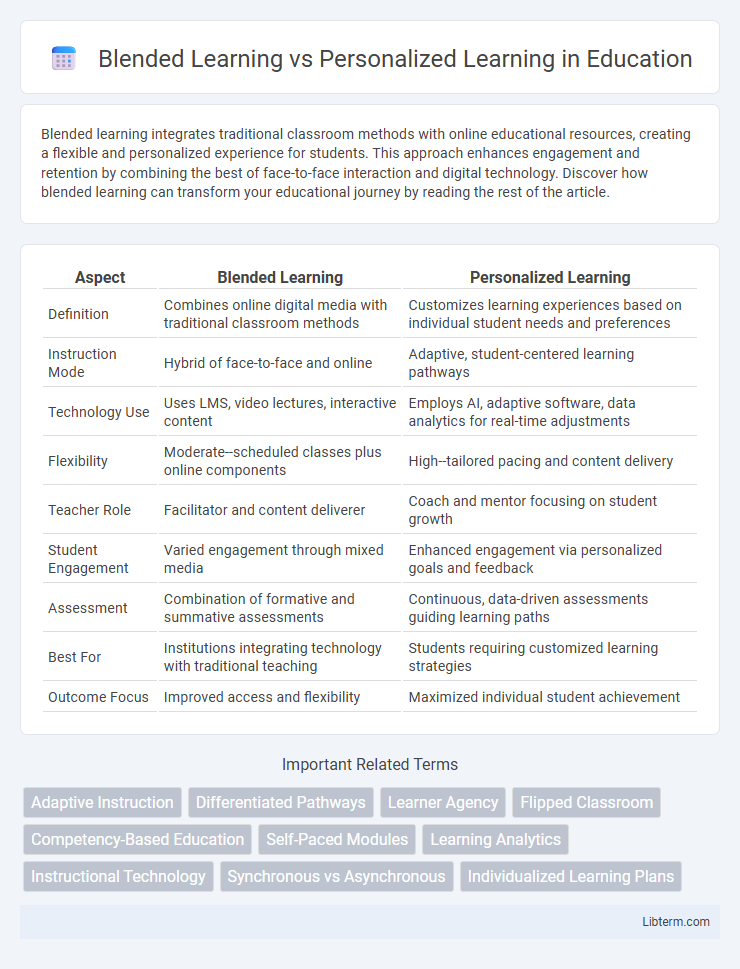Blended learning integrates traditional classroom methods with online educational resources, creating a flexible and personalized experience for students. This approach enhances engagement and retention by combining the best of face-to-face interaction and digital technology. Discover how blended learning can transform your educational journey by reading the rest of the article.
Table of Comparison
| Aspect | Blended Learning | Personalized Learning |
|---|---|---|
| Definition | Combines online digital media with traditional classroom methods | Customizes learning experiences based on individual student needs and preferences |
| Instruction Mode | Hybrid of face-to-face and online | Adaptive, student-centered learning pathways |
| Technology Use | Uses LMS, video lectures, interactive content | Employs AI, adaptive software, data analytics for real-time adjustments |
| Flexibility | Moderate--scheduled classes plus online components | High--tailored pacing and content delivery |
| Teacher Role | Facilitator and content deliverer | Coach and mentor focusing on student growth |
| Student Engagement | Varied engagement through mixed media | Enhanced engagement via personalized goals and feedback |
| Assessment | Combination of formative and summative assessments | Continuous, data-driven assessments guiding learning paths |
| Best For | Institutions integrating technology with traditional teaching | Students requiring customized learning strategies |
| Outcome Focus | Improved access and flexibility | Maximized individual student achievement |
Introduction to Blended and Personalized Learning
Blended learning integrates traditional face-to-face instruction with online educational content, creating a flexible learning environment that supports various learning styles and paces. Personalized learning tailors educational experiences to individual students' needs, preferences, and strengths through adaptive technologies and data-driven insights. Both approaches aim to enhance student engagement and outcomes by leveraging digital tools and pedagogical strategies that promote active learning.
Defining Blended Learning
Blended learning integrates traditional face-to-face classroom methods with online educational materials and interactive digital tools, creating a cohesive learning experience. This approach allows students to benefit from both direct teacher interaction and self-paced online activities tailored to curriculum goals. By combining synchronous and asynchronous instruction, blended learning enhances engagement and flexibility while maintaining structured guidance.
What is Personalized Learning?
Personalized learning is an educational approach that tailors instruction, pace, and learning experiences to meet the individual needs, skills, and interests of each student. It uses data-driven insights and adaptive technologies to create customized learning paths that optimize student engagement and achievement. Unlike blended learning, which integrates online and face-to-face modalities, personalized learning centers specifically on customizing content and delivery for unique learner profiles.
Key Differences Between Blended and Personalized Learning
Blended learning integrates traditional face-to-face instruction with online educational content, allowing students to control the time, place, and pace of their learning within a structured framework. Personalized learning tailors educational experiences to individual student's strengths, needs, and interests, often using data-driven methods to customize learning paths and feedback. The key difference lies in blended learning's hybrid delivery model versus personalized learning's focus on adaptive instruction tailored specifically to each learner's unique profile.
Benefits of Blended Learning Approaches
Blended learning combines traditional face-to-face instruction with online digital content, enhancing student engagement and flexibility. This approach allows educators to leverage diverse teaching methods, catering to varied learning styles and promoting deeper understanding. By integrating technology, blended learning supports continuous feedback and personalized pacing, improving overall academic outcomes.
Advantages of Personalized Learning Strategies
Personalized learning strategies enhance student engagement by tailoring instruction to individual learning styles, paces, and interests, which leads to improved academic outcomes. This approach leverages data-driven insights and adaptive technologies to provide targeted support, fostering deeper understanding and mastery of content. Personalized learning also promotes self-directed learning and critical thinking skills, empowering students to take ownership of their education.
Challenges of Implementing Blended Learning
Implementing blended learning faces challenges such as ensuring reliable technology infrastructure and addressing diverse student engagement levels. Educators must balance online digital content with traditional classroom methods while managing limited training and resources. These obstacles often impact the effectiveness and scalability of blended learning programs in varied educational settings.
Obstacles in Personalized Learning Adoption
Personalized learning adoption faces significant obstacles including high implementation costs, lack of teacher training, and insufficient technological infrastructure. Unlike blended learning, which integrates traditional and digital methods more seamlessly, personalized learning requires continuous data-driven adjustments that many schools find challenging to manage. These barriers often result in slower uptake and inconsistent effectiveness across educational institutions.
Choosing the Right Model: Factors to Consider
Choosing the right learning model requires evaluating key factors such as student learning styles, technological access, and curriculum flexibility. Blended learning integrates face-to-face instruction with online components, ideal for balancing structure and self-paced study, whereas personalized learning tailors content to individual progress and interests, demanding robust adaptive technologies. Schools must assess resources, teacher training, and student engagement levels to determine which model optimizes educational outcomes effectively.
Future Trends in Blended and Personalized Learning
Future trends in blended learning emphasize the integration of artificial intelligence to adapt content delivery and pacing for diverse learner needs. Personalized learning will increasingly leverage data analytics and machine learning algorithms to tailor educational experiences, enhancing student engagement and outcomes. The convergence of immersive technologies such as virtual reality and adaptive platforms is set to redefine how learners interact with content in both blended and personalized environments.
Blended Learning Infographic

 libterm.com
libterm.com